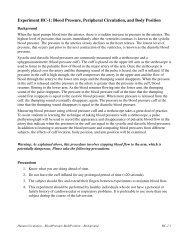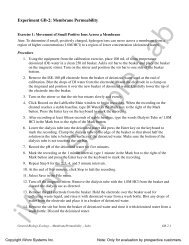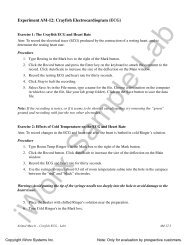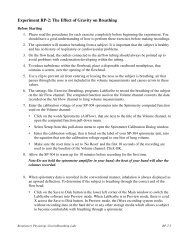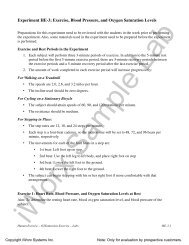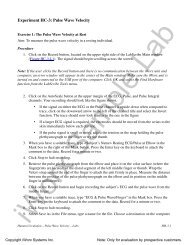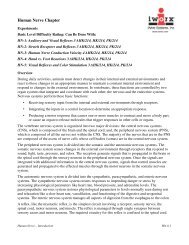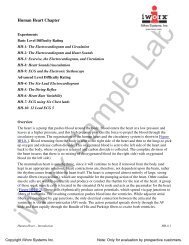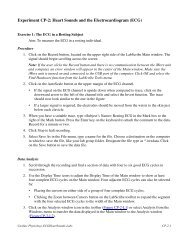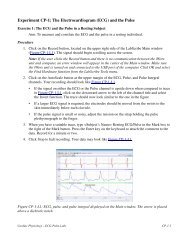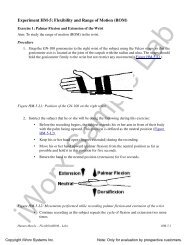Experiment AM-5: Intestinal Motility - iWorx
Experiment AM-5: Intestinal Motility - iWorx
Experiment AM-5: Intestinal Motility - iWorx
- No tags were found...
Create successful ePaper yourself
Turn your PDF publications into a flip-book with our unique Google optimized e-Paper software.
8. Click Stop to halt the recording when the intestinal activity appears consistent.9. Select Save in the File menu.10. Remove the Tyrode’s solution containing the acetylcholine from the bath chamber. Carefullyrinse the intestinal tissue and the bath chamber with fresh, warm solution a couple of times.This removes excess drug from the tissue and reduces the occurrence of multiple drug effects.11. Replace the solution in the chamber with fresh, warm Tyrode’s solution.Exercise 4: Blocking of Acetylcholine ReceptorsAim: To determine the effects of two different acetylcholine blocking agents, curare and atropine, onintestinal motility.Procedure1. Click the Record button. Record the activity of the intestinal muscle after the Tyrode’s solutionin the bath chamber was replaced. The contractions should be consistent and predictableproceeding with the exercise.2. Type Basal Activity-3 in the Mark box to the right of the Mark button. Press the Enter key onthe keyboard. Record basal activity for at least four complete cycles or 30 seconds (whicheveris longer). Continue recording3. Type Two Drops-1.0% Curare in the Mark box.4. Add two drops of 1.0% curare (d-tubocurarine) to the Tyrode’s solution in the bath chamber asthe Enter key on the keyboard is pressed. Wait at least 45 seconds to see if the curare causes anychange in the motility of the intestine. Continue recording.5. Type 0.1% Acetylcholine in the Mark box.6. Add acetylcholine to the Tyrode’s solution in the bath chamber as the Enter key on the keyboardis pressed. Use the smallest amount of acetylcholine that produced a visible effect in Exercise 3.If no effect is seen within thirty seconds of the addition of this dose of acetylcholine, addanother drop or two of the drug. Mark the recording when each additional drop is added to thebath chamber. Wait thirty seconds after the addition of each drop before adding additionaldrops.7. As soon as the response of the intestinal muscle is stable and consistent, click Stop to halt therecording.8. Select Save in the File menu.9. Remove the Tyrode’s solution containing the curare and acetylcholine from the bath chamber.Carefully rinse the intestinal tissue and the bath chamber with fresh, warm solution a couple oftimes. This removes excess drug from the tissue and reduces the occurrence of multiple drugeffects.10. Replace the solution in the chamber with fresh, warm Tyrode’s solution.<strong>iWorx</strong> Sample LabAnimal Muscle – <strong>Intestinal</strong><strong>Motility</strong>-LS2 – Labs<strong>AM</strong>-5-5Copyright <strong>iWorx</strong> Systems Inc.Note: Only for evaluation by prospective customers.
11. Click the Record button. Record the activity of the intestinal muscle after the Tyrode’s solutionin the bath chamber was replaced. The contractions should be consistent and predictableproceeding with the exercise.12. Type Basal Activity-4 in the Mark box. Press the Enter key on the keyboard. Record basalactivity for at least four complete cycles or 30 seconds (whichever is longer). Continuerecording13. Type Two Drops, 0.5% Atropine in the Mark box to the right of the Mark button.14. Add two drops of 0.5% atropine to the Tyrode’s solution in the bath chamber as the Enter keyon the keyboard is pressed. Wait at least 45 seconds to see if the atropine causes any change inthe motility of the intestine. Continue recording.15. Add acetylcholine to the Tyrode’s solution in the bath chamber as the Enter key on the keyboardis pressed. Use the smallest amount of acetylcholine that produced a visible effect in Exercise 3.If no effect is seen within thirty seconds of the addition of this dose of acetylcholine, addanother drop or two of the drug. Mark the recording when each additional drop is added to thebath chamber. Wait thirty seconds after the addition of each drop before adding additionaldrops.16. As soon as the response of the intestinal muscle is stable and consistent, click Stop to halt therecording.17. Select Save in the File menu.18. Remove the Tyrode’s solution containing the atropine and acetylcholine from the bath chamber.Carefully rinse the intestinal muscle and the bath chamber with fresh, warm solution a couple oftimes. This removes excess drug from the tissue and reduces the occurrence of multiple drugeffects.19. Replace the solution in the chamber with fresh, warm Tyrode’s solution.<strong>iWorx</strong> Sample LabAnimal Muscle – <strong>Intestinal</strong><strong>Motility</strong>-LS2 – Labs<strong>AM</strong>-5-6Copyright <strong>iWorx</strong> Systems Inc.Note: Only for evaluation by prospective customers.
Figure <strong>AM</strong>-5-L1: The effect of atropine on intestinal muscle motility followed by the effect ofacetylcholine in the presence of atropine.Exercise 5: Effect of EpinephrineAim: To examine the effect of epinephrine on the tone, amplitude, and frequency of musclecontractions.Procedure1. Click the Record button. Record the activity of the intestinal muscle after the Tyrode’s solutionin the bath chamber was replaced. The contractions should be consistent and predictableproceeding with the exercise.2. Type Basal Activity-5 in the Mark box to the right of the Mark button. Press the Enter key onthe keyboard. Record basal activity for at least four complete cycles or 30 seconds (whicheveris longer). Continue recording3. Type One Drop-0.05% Epinephrine in the Mark box.4. Add one drop of 0.05% epinephrine to the Tyrode’s solution in the bath chamber as the Enterkey on the keyboard is pressed. Wait at least 45 seconds to see if the epinephrine causes anychange in the motility of the intestine. Continue recording. Add another drop of 0.05%epinephrine to the bath chamber.5. As soon as the response of the intestinal muscle is stable and consistent, click Stop to halt therecording.6. Select Save in the File menu.<strong>iWorx</strong> Sample LabAnimal Muscle – <strong>Intestinal</strong><strong>Motility</strong>-LS2 – Labs<strong>AM</strong>-5-7Copyright <strong>iWorx</strong> Systems Inc.Note: Only for evaluation by prospective customers.
7. Remove the Tyrode’s solution containing the epinephrine from the bath chamber. Carefullyrinse the intestinal tissue and the bath chamber with fresh, warm solution a couple of times.This removes excess drug from the tissue and reduces the occurrence of multiple drug effects.8. Replace the solution in the chamber with fresh, warm Tyrode’s solution.Figure <strong>AM</strong>-5-L2: The effect of epinephrine on intestinal muscle motility.Exercise 6: Effect of SerotoninAim: To examine the effect of serotonin (5-Hydroxy- tryptamine) on the tone, amplitude, andfrequency of smooth muscle contractions.Procedure1. Click the Record button. Record the activity of the intestinal muscle after the Tyrode’s solutionin the bath chamber was replaced. The contractions should be consistent and predictableproceeding with the exercise.2. Type Basal Activity-6 in the Mark box to the right of the Mark button. Press the Enter key onthe keyboard. Record basal activity for at least four complete cycles or 30 seconds (whicheveris longer). Continue recording3. Type One Drop-0.01% Serotonin in the Mark box.<strong>iWorx</strong> Sample LabAnimal Muscle – <strong>Intestinal</strong><strong>Motility</strong>-LS2 – Labs<strong>AM</strong>-5-8Copyright <strong>iWorx</strong> Systems Inc.Note: Only for evaluation by prospective customers.
4. Add 1 drop of 0.01% serotonin (5-hydroxytryptamine) to the Tyrode’s solution in the bathchamber as the Enter key on the keyboard is pressed. Wait at least 30 seconds to see if theserotonin causes any change in the motility of the intestine. Continue recording. Add anotherdrop of 0.01% serotonin to the bath chamber.5. As soon as the response of the intestinal muscle is stable and consistent, click Stop to halt therecording.6. Select Save in the File menu.7. Remove the Tyrode’s solution containing the serotonin from the bath chamber. Carefully rinsethe intestinal tissue and the bath chamber with fresh, warm solution a couple of times. Thisremoves excess drug from the tissue and reduces the occurrence of multiple drug effects.8. Replace the solution in the chamber with fresh, warm Tyrode’s solution.Figure <strong>AM</strong>-5-L3: Effects of serotonin on intestinal muscle motility.Exercise 7: Effect of pHAim: To investigates the effects of lowering the pH of the fluid surrounding the tissue.The gastric contents are acid (pH of 2 in mammals), but after entering the duodenum, the luminalcontents become neutral, as bile from the liver and bicarbonate from the pancreas are added. The liningof the intestine also secretes its own alkaline fluid, so by the time food reaches the ileum, the pH is 7.5to 8 (about the pH of Tyrode’s solution). This raises the question of whether alkalinity helps or hindersintestinal motility. Because Tyrode’s is already alkaline, we will lower the pH of the fluid surroundingthe tissue specimen.<strong>iWorx</strong> Sample LabAnimal Muscle – <strong>Intestinal</strong><strong>Motility</strong>-LS2 – Labs<strong>AM</strong>-5-9Copyright <strong>iWorx</strong> Systems Inc.Note: Only for evaluation by prospective customers.
Procedure1. Begin this section of the exercise with slightly more Tyrode’s solution in the apparatus thanusual.2. Click the Record button. Record the activity of the intestinal muscle after the Tyrode’s solutionin the bath chamber was replaced. The contractions should be consistent and predictableproceeding with the exercise.3. Type Basal Activity-7 in the Mark box to the right of the Mark button. Press the Enter key onthe keyboard. Record basal activity for at least four complete cycles or 30 seconds (whicheveris longer). Continue recording.4. Use the pH paper provided to measure the acidity of the Tyrode’s solution in the bath chamber.Record this value as the Initial pH.5. Type Five Drops-5% HCl in the Mark box.6. Add five drops of 5% hydrochloric acid (HCl) to the Tyrode’s solution in the bath chamber asthe Enter key on the keyboard is pressed. Wait 15 seconds to see if the hydrochloric acid causesany change in the motility of the intestine.7. If there is no change in the muscle’s motility, add more 5% HCl in aliquots of five drops each.Wait fifteen seconds between additions. Add aliquots of 5% HCl until a sustained change in themotility of the intestine is noted (Figure <strong>AM</strong>-5-L4).8. Use the pH paper to measure the acidity of the Tyrode’s solution in the bath chamber. Recordthis pH value. If the pH of the solution is still >5, add an additional 8-10 drops of HCl andrecord the pH again.9. To verify the effects of acidity of smooth muscle activity, add 5% sodium hydroxide (NaOH) tothe Tyrode’s solution in the bath chamber in aliquots of three drops each. Add aliquots of 5%NaOH until the motility of the intestine is the same as at the beginning of Basal Activity -7.10. As soon as the response of the intestinal muscle is stable and consistent, click Stop to halt therecording. Measure and record the pH of the solution in the bath chamber.11. Select Save in the File menu.12. Remove the Tyrode’s solution containing acids and bases from the bath chamber. Carefullyrinse the intestinal tissue and the bath chamber with fresh, warm solution a couple of times.This removes excess drug from the tissue and reduces the occurrence of multiple drug effects.13. Replace the solution in the chamber with fresh, warm Tyrode’s solution.<strong>iWorx</strong> Sample LabAnimal Muscle – <strong>Intestinal</strong><strong>Motility</strong>-LS2 – Labs<strong>AM</strong>-5-10Copyright <strong>iWorx</strong> Systems Inc.Note: Only for evaluation by prospective customers.
Figure <strong>AM</strong>-5-L4: The effect of increasing acidity on intestinal muscle motility.Exercise 8: Effects of Calcium LevelsAim: To investigate the effects of calcium ion concentration in the extracellular fluid on smooth musclecontractions.Calcium ions have what appear to be two contradictory actions on muscle cells, depending on theconcentration of calcium ions in the extracellular fluid. This is especially true for those cells that relymost heavily on the extracellular fluid as their primary reservoir of calcium ions for contraction. Insmooth muscle cells, sufficient calcium ions must be present to bind with calmodulin and activate themyosin kinase, initiating the latch bridge cycle of smooth muscle contraction. If, however, too manycalcium ions are present, they can get “stuck” in sodium channels, thus decreasing the effectivepermeability of the cells to sodium ions. How would this action be expected to alter smooth musclecontractions? Would you expect the frequency or the amplitude of contraction to be altered to thegreatest degree?Procedure1. Click the Record button. Record the activity of the intestinal muscle after the Tyrode’s solutionin the bath chamber was replaced. The contractions should be consistent and predictableproceeding with the exercise.2. Type Basal Activity-8 in the Mark box to the right of the Mark button. Press the Enter key onthe keyboard. Record basal activity for at least four complete cycles or 30 seconds (whicheveris longer). Continue recording.<strong>iWorx</strong> Sample Lab3. Type Calcium-Deficient Saline in the Mark box.Animal Muscle – <strong>Intestinal</strong><strong>Motility</strong>-LS2 – Labs<strong>AM</strong>-5-11Copyright <strong>iWorx</strong> Systems Inc.Note: Only for evaluation by prospective customers.
4. While recording, quickly replace the regular Tyrode’s solution with a calcium-deficient solutionas the Enter key on the keyboard is pressed. Continue recording the resulting contractions for atleast 45 seconds.5. Type 5 Drops-20% Calcium Solution in the Mark box.Warning: Shake the dropper bottle containing the 20% calcium solution to be sure as much of thecalcium is in suspension as possible.6. Add five drops of 20% calcium solution to the calcium deficient saline in the bath chamber asthe Enter key on the keyboard is pressed. If no effect is seen in 45 seconds, add an additional 5drops of 20% calcium solution and mark the record. Record for another 45 seconds.7. Type High Calcium Saline in the Mark box.8. While recording, quickly replace the calcium-deficient Tyrode’s solution with the high-calciumsolution as the Enter key on the keyboard is pressed. As soon as the response of the intestinalmuscle is stable and consistent, click Stop to halt the recording.9. Select Save in the File menu.10. Remove the Tyrode’s solution containing the calcium from the bath chamber. Carefully rinsethe intestinal muscle and the bath chamber with fresh, warm solution a couple of times. Thisremoves excess drug from the muscle and reduces the occurrence of multiple drug effects.11. Replace the solution in the chamber with fresh, warm Tyrode’s solution.Exercise 9: Effect of CyanideAim: To investigate the effects of cyanide in the extracellular fluid on smooth muscle contractions.Potassium cyanide is cytotoxic because it binds to the iron of cytochrome oxidase, thus preventing thetransfer of electrons to oxygen and eventually halting all of aerobic respiration. Without the ability togenerate ATP, cells cannot perform any cellular work like maintaining their osmotic balance or repairthemselves. However, it is not uncommon to observe a short period of increased contractile activity inthe smooth muscle preparation immediately following the initial application of cyanide. Thisparadoxical effect of cyanide appears to be the result of the increased release of neurotransmittersubstances from the cells in the autonomic nervous system. The nerve endings of cells in the intrinsicintestinal nerve plexuses are stimulated by the presence of low levels of cyanide to release transmitters.Eventually, the cytotoxic effects of cyanide in all tissues overwhelms this effect.Procedure1. Click the Record button. Record the activity of the intestinal muscle after the Tyrode’s solutionin the bath chamber was replaced. The contractions should be consistent and predictableproceeding with the exercise.2. Type Basal Activity-9 in the Mark box to the right of the Mark button. Press the Enter key onthe keyboard. Record basal activity for at least four complete cycles or 30 seconds (whicheveris longer). Continue recording.<strong>iWorx</strong> Sample LabAnimal Muscle – <strong>Intestinal</strong><strong>Motility</strong>-LS2 – Labs<strong>AM</strong>-5-12Copyright <strong>iWorx</strong> Systems Inc.Note: Only for evaluation by prospective customers.
3. Type 1 Drop-0.5% Sodium Cyanide in the Mark box.4. Add one drop of 0.5% sodium cyanide to the Tyrode’s solution in the bath chamber as the Enterkey on the keyboard is pressed. Wait 10 seconds to see if the sodium cyanide causes any changein the motility of the intestine. Add additional drops of 0.5% sodium cyanide to the solution inthe bath chamber. Add one drop at a time, waiting at least ten seconds between drops. Mark therecording each time a drop is added to the bath.5. Continue to record until no activity in the intestinal muscle is observed. Click Stop to halt therecording.6. Select Save in the File menu.Warning: When finished, be sure to follow the instructor’s directions for cleaning your lab area andequipment.Data Analysis1. Scroll to the beginning of the data file and locate a section in the recording of normal intestinalcontractions where the amplitude and period of the contraction cycle are consistent.2. Use the Display Time icons to adjust the Display Time of the Main window so that twointestinal contraction cycles are displayed on the Main window. This section of data can also beselected by:• Placing the cursors on either side of the two contraction cycles of the recording, and• Clicking the Zoom between Cursors button on the LabScribe toolbar to expand orcontract the contraction cycle recording to the width of the Main window.3. Click on the Analysis window icon in the toolbar or select Analysis from the Windows menu totransfer the data displayed in the Main window to the Analysis window.4. Look at the Function Table that is above the <strong>Intestinal</strong> Tension Channel in the Analysis window.The mathematical functions, Value1, Value2, V2-V1, and T2-T1, should appear in this table.The values for these parameters are displayed in the table across the top margin of the <strong>Intestinal</strong>Tension channel.5. Maximize the height of the trace on the <strong>Intestinal</strong> Tension Channel by clicking on the arrow tothe left of the channel’s title to open the channel menu. Select Scale from the menu andAutoScale from the Scale submenu to increase the height of the data on that channel.6. Once the cursors are placed in the correct positions for determining the amplitude and period ofeach intestinal contraction, the values of the parameters in the Function Table can be recordedin the on-line notebook of LabScribe by typing their names and values directly into the Journal,or on a separate data table.7. The functions in the channel pull-down menus of the Analysis window can also be used to enterthe names and values of the parameters from the recording to the Journal. To use thesefunctions:<strong>iWorx</strong> Sample Lab• Place the cursors at the locations used to measure the amplitude and times of eachintestinal contraction.Animal Muscle – <strong>Intestinal</strong><strong>Motility</strong>-LS2 – Labs<strong>AM</strong>-5-13Copyright <strong>iWorx</strong> Systems Inc.Note: Only for evaluation by prospective customers.
• Transfer the names of the mathematical functions used to determine the amplitude andtimes to the Journal using the Add Title to Journal function in the <strong>Intestinal</strong> TensionChannel pull-down menu.• Transfer the values for the amplitude and times to the Journal using the Add Ch. Data toJournal function in the <strong>Intestinal</strong> Tension Channel pull-down menu.8. On the <strong>Intestinal</strong> Tension Channel, use the mouse to click on and drag the cursors to specificpoints on the recording to measure the following parameters:• Contraction Amplitude is the active tension, or phasic response, developed in theintestine during its contraction. To measure this parameter, place one cursor at thebeginning of the contraction, and the second cursor on its peak. The value for the V2-V1function on the <strong>Intestinal</strong> Tension Channel is the contraction amplitude.• Contraction Time is the time between the beginning and the peak of the contraction. Tomeasure this parameter, keep the cursors in the same positions used to measure thecontraction amplitude. The value for the T2-T1 function on the <strong>Intestinal</strong> TensionChannel is the contraction time.• Relaxation Time is the time between the peak and the end of the contraction. To measurethis parameter, keep the cursor on the peak of the contraction and place the other cursorat the end of the contraction. The value for the T2-T1 function on the <strong>Intestinal</strong> TensionChannel is the relaxation time.• Contraction Period is the time between the beginnings of adjacent contractions. Tomeasure this parameter, place one cursor at the beginning of one contraction and theother cursor at the beginning of the adjacent contraction. The value for the T2-T1function on the <strong>Intestinal</strong> Tension Channel is the contraction period.• <strong>Intestinal</strong> Tone is the passive tension, or tonic response, present in the intestine before orafter the contraction. To measure this parameter, keep the cursors in the same positionsused to measure the contraction period. Value1 on the <strong>Intestinal</strong> Tension Channel is thetone of the intestine at the beginning of a contraction, and Value2 is the intestinal tone atthe beginning of the adjacent contraction.9. Record the values in the Journal using the one of the techniques described in Steps 6 or 7, andon Table <strong>AM</strong>-5-L1.10. Repeat Steps 2 through 9 to find the contraction amplitude, contraction time, relaxation time,contraction period, and intestinal tone of all the other basal activity levels and intestinal muscleresponse to the treatments delivered to the tissue. Record the values in the Journal and on Table<strong>AM</strong>-5-L1.11. Select Save in the File menu.<strong>iWorx</strong> Sample LabAnimal Muscle – <strong>Intestinal</strong><strong>Motility</strong>-LS2 – Labs<strong>AM</strong>-5-14Copyright <strong>iWorx</strong> Systems Inc.Note: Only for evaluation by prospective customers.
QuestionsExercise 2-Effect of Stretch1. How does stretching the intestinal strip affect intestinal motility (tone, amplitude, andfrequency)?2. By what mechanism does stretch influence the contraction of smooth muscle cells?3. Is the response of smooth muscle to stretch different from the responses of skeletal and cardiacmuscles to stretch? If so, in what way(s)?4. Do the amplitudes of intestinal muscle contractions depend upon muscle length?5. Does intestinal muscle tone depend upon muscle length?6. Does the frequency of intestinal muscle contractions depend upon muscle length?7. Do your observations support the sliding filament theory for muscle contraction?8. Do your observations supply evidence for plasticity?9. How do your results compare to the length-tension relationship that exists in skeletal muscle?Exercise 3-Effect of Acetylcholine1. Acetylcholine acts by increasing the permeability of smooth muscle cells to ions such as sodiumand potassium. Do your results correspond to the effects of the increased movement of theseions?2. Which division of the autonomic nervous system primarily releases acetylcholine at synapseswith effector cells?3. Acetylcholine is also released from the intestinal wall itself. The amount released isproportional to the degree of gut tone as demonstrated by measuring the concentration ofacetylcholine in the fluid surrounding isolated intestine stretched to various degrees. Whateffect is the irregular release of acetylcholine from axon terminals and intestinal walls going tohave on the mixing of partially-digested food and digestive secretions, and the movement of the“food” bolus through the digestive tract of an intact animal? Is acetylcholine going to aid orinhibit the digestive process?Exercise 4-Blocking of Acetylcholine Receptors1. Before beginning the experiment, find out which population of acetylcholine receptors isspecifically blocked by the presence of curare and which receptors have their activity blockedby the presence of atropine.2. What effect does curare have on intestinal motility (tone, amplitude, frequency)? What effectdoes curare have on intestinal motility in the presence of acetylcholine?3. What effect does atropine have on intestinal motility (tone, amplitude, frequency)? What effectdoes atropine have on intestinal motility in the presence of acetylcholine?<strong>iWorx</strong> Sample Lab4. Hypothesize mechanisms by which each drug affects the contractility of the intestinal muscle.Animal Muscle – <strong>Intestinal</strong><strong>Motility</strong>-LS2 – Labs<strong>AM</strong>-5-15Copyright <strong>iWorx</strong> Systems Inc.Note: Only for evaluation by prospective customers.
5. Based on your results and the known functions of curare and atropine, which type(s) ofacetylcholine receptors are found on intestinal smooth muscle cells? How do your resultsconfirm this?Exercise 5-Effect of EpinephrineConsider the nature of the joint regulation of gut motility while examining the effects of epinephrine.Epinephrine stabilizes smooth muscle cell membranes so that sodium enters cells less readily and therate of active transport of sodium out of the cell is doubled. Acetylcholine acts by increasing thepermeability of smooth muscle cells to ions such as sodium and potassium; but less of it is secreted inthe presence of epinephrine.1. What is the normal source of epinephrine in the body?2. How does the activity of norepinephrine usually compare to the activity of epinephrine at atarget tissue?3. What effect did epinephrine have on intestinal motility (tone, amplitude, frequency)?4. Do your results fit this model of the mechanism of the action of epinephrine?5. Would the presence of epinephrine increase or decrease the effectiveness of contractile stimuli(a food bolus, distention of the gut wall) to change intestinal motility?Exercise 6-Effect of SerotoninThe gut synthesizes large quantities of serotonin, especially after meals and during bursts of peristalsis.The intestine releases as much as eight times more serotonin when intraluminal pressures rise from 15to 60 mmH 2O.1. If serotonin lowers the threshold for mechanical excitation of intestinal stretch receptors andsensitizes the intestine to the action of acetylcholine, what is the expected effect of serotoninalone on smooth muscle activity? Why would this be a benefit?2. What effect did serotonin alone have on intestinal motility (tone, amplitude, frequency)?3. Hypothesize a mechanism by which serotonin affects the contractility of the intestinal muscle.Exercise 7-Effect of pH1. What effect did lowering the pH of the Tyrode’s solution have on intestinal motility (tone,amplitude, frequency)?2. What effect did restoring the pH of the Tyrode’s solution to its normal level have on intestinalmotility?3. How would an acidic food bolus affect intestinal motility?4. Hypothesize a mechanism by which pH affects the contractility of the intestinal muscle.<strong>iWorx</strong> Sample LabAnimal Muscle – <strong>Intestinal</strong><strong>Motility</strong>-LS2 – Labs<strong>AM</strong>-5-16Copyright <strong>iWorx</strong> Systems Inc.Note: Only for evaluation by prospective customers.
Exercise 8-Effect of Calcium Levels1. What effect did the lack of calcium in Tyrode’s solution have on intestinal motility (tone,amplitude, frequency)?2. What effect did adding calcium to the calcium-deficient Tyrode’s solution have on intestinalmotility?3. What effect did a high calcium concentration in Tyrode’s solution have on intestinal motility?4. Hypothesize a mechanism by which calcium affects the contractility of the intestinal muscle.Exercise 9-Effect of Cyanide1. What effect did cyanide in Tyrode’s solution initially have on intestinal motility?2. What effect did cyanide in Tyrode’s solution finally have on intestinal motility?3. Hypothesize a mechanism by which cyanide affects the contractility of the intestinal muscle.<strong>iWorx</strong> Sample LabAnimal Muscle – <strong>Intestinal</strong><strong>Motility</strong>-LS2 – Labs<strong>AM</strong>-5-17Copyright <strong>iWorx</strong> Systems Inc.Note: Only for evaluation by prospective customers.
Table <strong>AM</strong>-5-L1: Tone, Amplitude, and Frequency of <strong>Intestinal</strong> Muscle Activity as a Function ofStretch, Transmitters, Drugs, Acidity, and Calcium.TreatmentBasal Activity -1Application ofStretchBasal Activity -2Addition ofAcetylcholine(ACH)Basal Activity -3Addition ofCurareAddition ofACH withCurare presentBasal Activity -4Addition ofAtropineAddition ofACH withAtropine presentBasal Activity -5ContractionAmplitude(g)ContractionTime (sec)RelaxationTime (sec)ContractionPeriod (sec)<strong>Intestinal</strong>Resp.(g) atBeginning<strong>Intestinal</strong>Resp. (g)at End<strong>iWorx</strong> Sample LabAnimal Muscle – <strong>Intestinal</strong><strong>Motility</strong>-LS2 – Labs<strong>AM</strong>-5-18Copyright <strong>iWorx</strong> Systems Inc.Note: Only for evaluation by prospective customers.
Addition ofEpinephrineBasal Activity -6Addition ofSerotoninBasal Activity -7 (NormalpH___)1 o Activity ∆(new pH___)2 o Activity ∆(Lowest pH___)Return to normal(Normal pH___)Basal Activity -8Addition of lowCalcium bathAddition of 20%CaCl2 2dropsAddition of highCalcium bathBasal Activity -9Addition ofSodium Cyanide<strong>iWorx</strong> Sample LabAnimal Muscle – <strong>Intestinal</strong><strong>Motility</strong>-LS2 – Labs<strong>AM</strong>-5-19Copyright <strong>iWorx</strong> Systems Inc.Note: Only for evaluation by prospective customers.



